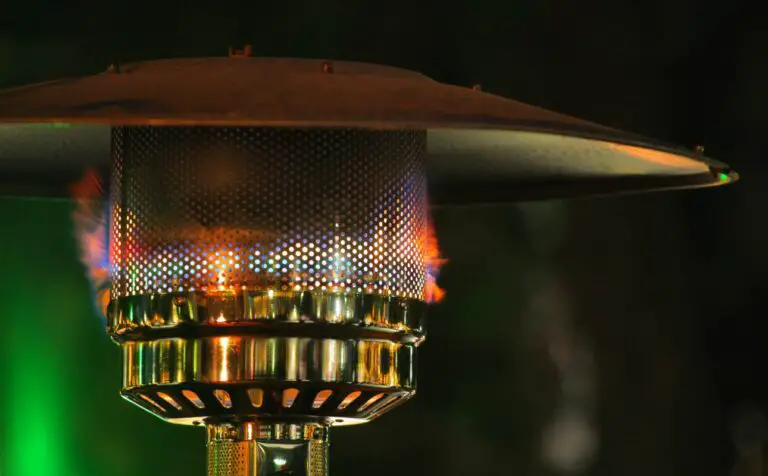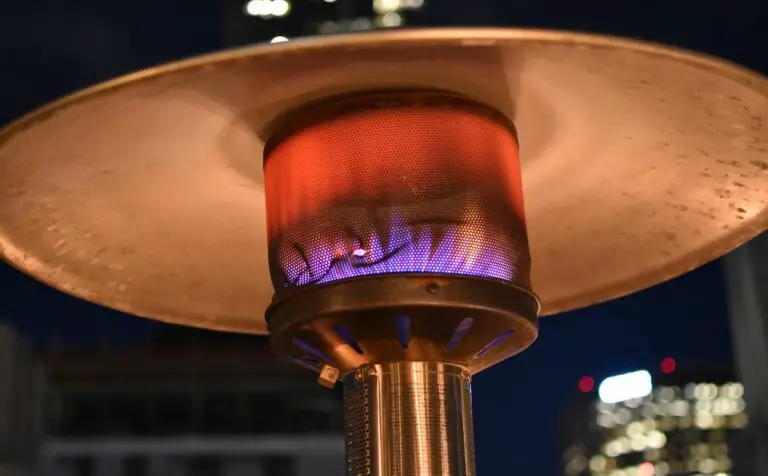If you’re looking to stay warm during the colder months, you might be considering purchasing a patio heater. However, you may be wondering if you can use a patio heater indoors. The short answer is no, you should not use a patio heater indoors.
Patio heaters are designed to be used in outdoor spaces, such as patios, decks, and other open-air areas. They are not intended for indoor use, as they can pose a serious safety risk if used improperly. Patio heaters are typically powered by propane gas or electricity, and both of these fuel sources can produce carbon monoxide, which is a colorless, odorless gas that can be deadly in high concentrations.
While it may be tempting to use a patio heater indoors to keep warm, it’s important to remember that doing so can be extremely dangerous. Instead, if you need to heat an indoor space, consider using a heater that is specifically designed for indoor use. These heaters are designed with safety features that make them safe to use in enclosed spaces, and they are typically more efficient and cost-effective than outdoor heaters.

Understanding Patio Heaters
If you’re considering purchasing a patio heater, it’s important to understand what they are and how they work. Patio heaters are designed to provide warmth in outdoor spaces, such as patios, decks, and outdoor dining areas. They come in various types, including electric, gas, propane, natural gas, and infrared patio heaters.
Types of Patio Heaters
Electric Patio Heaters
Electric patio heaters are powered by electricity and are easy to use. They come in various sizes and shapes, and some models can be mounted to walls or ceilings. They are ideal for small outdoor spaces, such as balconies and patios.
Gas Patio Heaters
Gas patio heaters are powered by propane gas or natural gas. They come in various sizes and shapes, and some models can be mounted to walls or ceilings. They are ideal for large outdoor spaces, such as decks and outdoor dining areas.
Infrared Patio Heaters
Infrared patio heaters use infrared radiation to heat objects and people directly, rather than heating the air around them. They are ideal for outdoor spaces with high wind or drafts.
Outdoor vs. Indoor Use
It’s important to note that patio heaters are designed for outdoor use only. They are not safe to use indoors because they produce a high level of heat and carbon monoxide. Indoor heaters are designed for use indoors and produce significantly less heat and no carbon monoxide.
Portable Patio Heaters
Portable patio heaters are a popular choice for outdoor spaces because they are easy to move around and can be used in various locations. They come in various types, including propane heaters and electric heaters. Propane heaters are ideal for outdoor spaces with no access to electricity, while electric heaters are ideal for small outdoor spaces, such as balconies and patios.
In summary, patio heaters are a great way to enjoy your outdoor space even on chilly evenings. However, it’s important to understand the different types of patio heaters available and their appropriate use. Remember, patio heaters are designed for outdoor use only, so never use them indoors.
The Risks of Using Patio Heaters Indoors
Using patio heaters indoors can be dangerous and pose serious risks to your health and safety. Here are some of the risks you should be aware of:
Carbon Monoxide Poisoning
Patio heaters produce carbon monoxide, a colorless and odorless gas that can cause carbon monoxide poisoning. Symptoms of carbon monoxide poisoning include persistent tiredness, shortness of breath, headaches, nausea, vomiting, and loss of consciousness. Using a patio heater indoors can increase the risk of carbon monoxide poisoning, especially if the room is poorly ventilated.
Fire Hazard
Patio heaters are designed for outdoor use and are not intended for indoor use. Using a patio heater indoors can increase the risk of fire hazards, especially if the heater is placed near flammable materials such as curtains, furniture, or paper. The high temperature of the heater can ignite these materials and cause a fire.
Emissions
Patio heaters produce emissions such as nitrogen dioxide and nitric oxide, which can be harmful to your health. These pollutants can cause respiratory problems, especially in people with pre-existing conditions such as asthma or chronic obstructive pulmonary disease (COPD). Using a patio heater indoors can increase the concentration of these pollutants and worsen respiratory symptoms.
Overall Safety
In summary, using a patio heater indoors is not safe and can pose serious risks to your health and safety. It is important to use indoor heaters that are designed for indoor use and produce significantly less heat and no carbon monoxide. Additionally, make sure to follow all safety instructions and guidelines when using any type of heater indoors.
Safety Precautions When Using Patio Heaters Indoors
If you’re considering using a patio heater indoors, it’s important to keep safety in mind. While patio heaters are designed for outdoor use, there are some models that can be used indoors. Here are some safety precautions you should take when using a patio heater indoors:
Safety Guidelines
First and foremost, always read and follow the manufacturer’s instructions for your specific patio heater model. This will ensure that you are using it safely and correctly. Additionally, make sure that your patio heater has an automatic shut-off feature that turns the unit off if it tips over.
Clearance
When using a patio heater indoors, it’s important to make sure that it has enough clearance around it. This means keeping it away from walls, furniture, curtains, and other flammable materials. There should be at least three feet of clearance on all sides of the heater.
Air Circulation
Proper air circulation is crucial when using a patio heater indoors. Make sure that the area where you’re using the heater is well-ventilated, with windows or doors open to allow fresh air in. This will help to prevent the buildup of harmful gases like carbon monoxide.
Stable Surface
Make sure that your patio heater is placed on a stable, level surface. This will help to prevent it from tipping over and causing a fire or other safety hazard.
Proper Ventilation
If you’re using a gas or propane patio heater indoors, it’s important to make sure that it is properly vented. This means connecting it to a vent pipe or flue that will carry the exhaust gases outside. Failure to do so can result in a buildup of harmful gases like carbon monoxide, which can be deadly.
Remember, safety should always be your top priority when using a patio heater indoors. By following these safety precautions, you can enjoy the warmth and comfort of your patio heater without putting yourself or others at risk.
Understanding Different Fuel Types for Patio Heaters
When it comes to patio heaters, there are different fuel types to consider. Each fuel type has its own advantages and disadvantages, and it’s important to choose the right one for your needs. Here are some of the most common fuel types for patio heaters:
Propane Gas
Propane gas is a popular choice for patio heaters because it’s portable and easy to use. Propane tanks can be easily refilled or replaced, making it a convenient option for outdoor use. However, propane gas can be expensive, and you’ll need to keep an eye on the tank level to avoid running out of fuel.
Natural Gas
Natural gas is another popular option for patio heaters. It’s a cost-effective fuel source and provides a constant supply of heat. If you have a natural gas line installed in your home, you can easily connect your patio heater to it. However, natural gas patio heaters are not portable and require professional installation.
Electricity
Electric patio heaters are easy to use and require no fuel or gas. They’re also environmentally friendly and produce no emissions. However, they can be expensive to operate and may not provide as much heat as gas-powered heaters.
Butane Gas
Butane gas is another fuel option for patio heaters. It’s similar to propane gas in that it’s portable and easy to use. However, butane gas is not as widely available as propane gas, so you may have trouble finding it in some areas.
When choosing a fuel type for your patio heater, consider factors such as cost, convenience, and availability. Each fuel type has its own pros and cons, so it’s important to weigh them carefully before making your decision.
Considerations for Using Patio Heaters in Various Indoor Spaces
If you’re thinking about using a patio heater indoors, there are a few things you should consider to ensure your safety and the safety of those around you. Here are some things to keep in mind when using a patio heater in different indoor spaces.
Garage
A garage can be a tempting place to use a patio heater, especially if you’re working on a project or just want to hang out in a heated space. However, using a patio heater in a garage can be dangerous if you don’t take the proper precautions.
First and foremost, make sure your garage is well-ventilated. This means opening windows and doors to allow fresh air to circulate. Carbon monoxide can build up quickly in enclosed spaces, and this can be deadly.
Additionally, make sure you’re using a patio heater that’s designed for outdoor use. Indoor heaters are designed differently and may not be safe to use in a garage or other outdoor space.
Sunroom
A sunroom can be a great place to use a patio heater, as long as you take the proper precautions. Again, ventilation is key. Make sure your sunroom has plenty of windows and doors that can be opened to allow fresh air to circulate.
You should also make sure you’re using a patio heater that’s appropriate for the size of your sunroom. A heater that’s too small won’t provide enough heat, while a heater that’s too large can be dangerous.
Other Indoor Spaces
Using a patio heater in other indoor spaces, like a living room or bedroom, is not recommended. Patio heaters are designed for outdoor use and are not safe to use indoors.
If you’re looking for a way to heat your indoor spaces, consider using a space heater or central heating system instead. These options are designed for indoor use and are much safer than using a patio heater indoors.
Remember, safety should always be your top priority when using any type of heating device. By following these guidelines, you can enjoy the warmth of a patio heater safely and comfortably, no matter where you choose to use it.
Frequently Asked Questions
Is it safe to use an outdoor propane heater indoors?
No, it is not safe to use an outdoor propane heater indoors. Propane heaters produce Carbon Monoxide (CO) which can be harmful if inhaled in an unventilated area.
Can electric patio heaters be used inside the house?
Yes, electric patio heaters can be used inside the house. However, it is important to ensure that the heater is specifically designed for indoor use. Electric patio heaters are safe to use indoors as they don’t produce harmful gases.
Can a patio heater be used in an enclosed area?
Yes, a patio heater can be used in an enclosed area, but only if the area is well-ventilated. It is safe to use patio heaters in enclosed areas like screened porches or covered patios, as long as the area is well-ventilated.
Are portable gas heaters safe to use indoors?
No, portable gas heaters are not safe to use indoors. Gas patio heaters produce carbon monoxide, nitric oxide, and nitrogen dioxide which can be fatal if inhaled in an unventilated area.
Can you use a patio heater in a garage with the door open?
No, you should not use a patio heater in a garage with the door open. Patio heaters produce harmful gases that can be fatal if inhaled in an unventilated area.
Can outdoor heaters be used indoors?
No, outdoor heaters should not be used indoors. Outdoor patio heaters run much hotter than indoor heaters, have a low center of gravity, and can emit harmful gases, posing a serious fire hazard.


